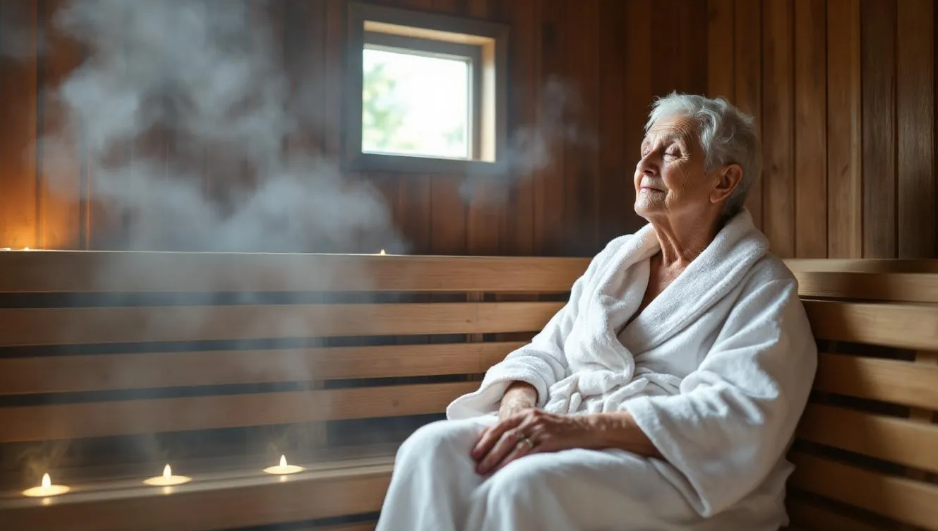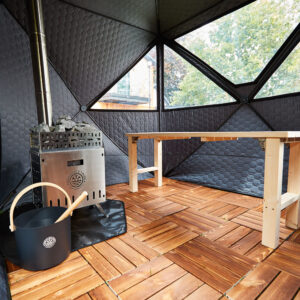
Ice Baths: A Key to Enhanced Recovery and Vitality for Athletes
Explore how ice baths can boost recovery and enhance vitality for athletes. Discover practical tips and insights to elevate your performance. Read more!
Christmas Delivery: UK orders by 10am, 19th Dec. Ireland/EU by 12pm, 15th Dec. Dispatch resumes 2nd Jan.
Spend Over £500 To Get Free UK Delivery - Excludes Certain Postcodes & Round Ice Baths
Delivery to Ireland now available

Living with arthritis, finding effective pain relief often feels like an endless journey through pharmaceutical options with diminishing returns. While traditional treatments remain essential, many patients are discovering that sauna therapy offers a promising complementary approach to managing their chronic pain and inflammation.
Recent clinical research reveals that regular sauna use can significantly reduce arthritis symptoms, with some studies showing up to 40% pain reduction in rheumatoid arthritis patients. This ancient practice, now backed by modern science, provides a non-pharmacological pathway to improved quality of life for those struggling with joint pain and stiffness.
Arthritis encompasses over 100 different joint conditions, but the two most common forms affecting sauna users are rheumatoid arthritis and osteoarthritis. These chronic conditions create a cascade of symptoms that significantly impact daily routine and well being.

Rheumatoid arthritis ra represents an autoimmune disorder where the body’s immune system attacks healthy joint tissues, causing severe inflammation, swelling, and progressive joint destruction. This systemic disease affects approximately 0.5-1% of the global population and often leads to chronic fatigue, poor sleep, and diminished quality of life.
Osteoarthritis, the more prevalent form, results from wear-and-tear damage to joint cartilage over time. This degenerative joint condition primarily affects weight-bearing joints like knees and hips, causing stiffness, pain, and reduced mobility that worsens with age.
Traditional treatments for these conditions rely heavily on medications – NSAIDs for pain management and disease-modifying antirheumatic drugs (DMARDs) for rheumatoid arthritis. However, these pharmaceutical approaches often come with significant adverse effects including gastrointestinal complications, cardiovascular risks, and immunosuppression.
Heat therapy emerges as a valuable non-pharmacological treatment option that addresses core arthritis symptoms through multiple biological mechanisms. Unlike medications that target specific pathways, sauna therapy provides systemic benefits that can improve various treatments outcomes while supporting the body’s natural healing processes.
The appeal of using a sauna for arthritis management lies in its ability to provide whole-body therapeutic heat exposure without the side effects associated with long-term medication use. This makes it particularly attractive for patients seeking to reduce their reliance on pharmaceuticals or those who cannot tolerate certain medications.
Understanding how heat therapy works reveals why sauna sessions can be so beneficial for managing arthritis symptoms. The physiological responses triggered by sauna use create a cascade of healing effects throughout the body.
When exposed to sauna heat, blood vessels dilate significantly, increasing blood flow to affected joints and surrounding tissues. This enhanced blood circulation delivers oxygen and nutrients more efficiently while helping remove inflammatory waste products that contribute to joint pain and stiffness.
The improved circulation particularly benefits patients with rheumatoid arthritis symptoms, as the increased blood flow helps reduce the chronic inflammation characteristic of this autoimmune condition. For osteoarthritis patients, better circulation supports cartilage health by improving the delivery of nutrients to joint tissues.
Heat exposure also triggers the release of endorphins – the body’s natural pain-relieving compounds. These neurotransmitters bind to opioid receptors in the brain and spinal cord, creating a natural analgesic effect that can provide hours of pain relief after a sauna session. This endorphin release explains why many patients report feeling significantly less pain and improved mental health following regular sauna use.
Perhaps most importantly for arthritis patients, sauna therapy demonstrates measurable anti-inflammatory effects. Clinical studies show reductions in key inflammatory markers including C-reactive protein (CRP), tumor necrosis factor-alpha (TNF-α), and various pro-inflammatory cytokines. This systemic reduction in inflammation can help reduce disease activity in both rheumatoid arthritis and osteoarthritis.
The heat also promotes ATP production at the cellular level, enhancing the body’s ability to repair damaged tissues. While this cellular repair mechanism requires more research in arthritis patients specifically, the theoretical framework suggests that regular heat exposure could support long-term joint health.
When considering sauna therapy for arthritis, the choice between infrared and traditional saunas significantly impacts treatment effectiveness and patient comfort. Understanding these differences helps patients make informed decisions about their heat therapy approach.
Infrared saunas utilise far-infrared light to heat the body directly, rather than heating the surrounding air. This infrared light penetrates 3-5 centimetres beneath the skin surface, delivering therapeutic heat directly to joints, muscles, and connective tissues. The deeper tissue penetration makes infrared saunas particularly effective for joint conditions like arthritis.
Traditional Finnish saunas operate at much higher temperatures compared to infrared saunas. While both types provide therapeutic benefits, the lower operating temperature of infrared units makes them more tolerable for patients with health conditions that may be sensitive to extreme heat, including many older adults with arthritis.
The direct heating mechanism of infrared saunas also means patients begin experiencing therapeutic effects more quickly, often within the first 10-15 minutes of a session. This efficiency allows for shorter treatment times while still achieving significant symptom relief.
For arthritis patients specifically, infrared saunas offer several advantages: better tolerance for those with cardiovascular concerns, deeper penetration to affected joints, and the ability to gradually increase session duration as comfort improves. The gentler heat environment also reduces the risk of dehydration and overheating – important considerations for patients who may be taking medications that affect thermoregulation.
Cost and accessibility considerations also favour infrared options for many patients. Home infrared sauna units are increasingly affordable and require less installation complexity than traditional steam room setups, making regular therapy more accessible for long-term arthritis management.
Patients with rheumatoid arthritis experience some of the most dramatic improvements from regular sauna therapy. Clinical research demonstrates that infrared sauna sessions can reduce pain scores by approximately 40% and decrease stiffness by up to 50% after just four weeks of consistent use.
The autoimmune nature of rheumatoid arthritis means that systemic inflammation drives much of the joint damage and associated symptoms. Sauna therapy addresses this root cause by modulating the immune response and reducing pro-inflammatory cytokine production. Patients often notice improvements in fatigue levels and sleep quality – two symptoms that significantly impact quality of life in rheumatoid arthritis.
Many patients also report reduced morning stiffness duration after incorporating sauna sessions into their weekly routine. This improvement in morning symptoms can dramatically enhance a patient’s ability to engage in daily activities and maintain independence.
The heat therapy appears to have mood-stabilising effects as well, with many patients experiencing reduced depression scores and improved overall well being. This mental health benefit is particularly valuable for rheumatoid arthritis patients, who face increased rates of depression and anxiety compared to the general population.
Some patients find they can reduce their reliance on pain medications when using sauna therapy consistently, though this should always be done under medical supervision. The natural pain relief provided by heat therapy can complement pharmaceutical treatments and potentially allow for lower medication doses in some cases.
For osteoarthritis patients, sauna therapy offers different but equally valuable benefits focused primarily on joint function and pain management. The heat exposure helps maintain joint flexibility and range of motion by improving tissue elasticity and reducing muscle tension around affected joints.
Clinical studies show that osteoarthritis patients using regular sauna therapy experience 30-50% reductions in pain intensity scores. This pain relief often translates into improved physical function and greater ability to participate in activities of daily living.
The enhanced blood flow promoted by sauna sessions may help support cartilage health by improving nutrient delivery to joint tissues. While cartilage has limited regenerative capacity, optimising its nutritional environment could potentially slow degenerative changes.
Many osteoarthritis patients find that sauna sessions help reduce the chronic muscle pain that often accompanies joint problems. As the body compensates for painful joints, surrounding muscles can become chronically tense and painful. The muscle relaxation provided by heat therapy addresses this secondary source of discomfort.
Weight-bearing joints like knees and hips, commonly affected by osteoarthritis, seem to respond particularly well to the deep tissue heating provided by infrared saunas. Patients often report improved mobility and reduced stiffness in these large joints following regular sauna use.
Arthritis patients, particularly those with rheumatoid arthritis, face significantly elevated cardiovascular risks compared to the general population. The chronic inflammation associated with these conditions contributes to accelerated atherosclerosis, increased risk of heart attack and stroke, and higher rates of heart failure.
Regular sauna use provides cardiovascular benefits that are especially valuable for arthritis patients. The heat exposure causes systemic vasodilation, which can help normalise blood pressure and reduce arterial stiffness – key factors in cardiovascular health.
Large epidemiological studies from Finland demonstrate that frequent sauna users have substantially lower rates of cardiovascular events, including reduced risk of sudden cardiac death and congestive heart failure. For arthritis patients already at elevated cardiovascular risk, these protective effects represent an important additional benefit of heat therapy.
The improved heart rate variability associated with regular sauna use indicates better autonomic nervous system balance. This improved autonomic function can enhance the body’s ability to manage stress and inflammation – both critical factors in arthritis management.
Sauna sessions also appear to improve endothelial function – the ability of blood vessels to dilate and contract properly. This vascular health improvement can enhance circulation to joints and support the cardiovascular system’s overall resilience.
Implementing sauna therapy safely and effectively requires a systematic approach that gradually acclimates the body to heat exposure while maximising therapeutic benefits. Patients new to sauna use should start conservatively and build tolerance over time.
Begin with short sessions of 10-15 minutes at moderate temperatures. For infrared saunas, start at approx 54℃, while traditional sauna users should begin around approx 70℃. This gradual introduction allows the cardiovascular system to adapt and helps identify any individual sensitivities to heat exposure.

Frequency recommendations suggest starting with 2 sessions per week for the first month, then gradually increase to 3 weekly sessions as tolerance improves. This schedule provides therapeutic benefits while allowing adequate recovery time between sessions.
Duration should progressively increase over 2-4 weeks, working up to 20-30 minute sessions for optimal benefit. Most clinical studies showing significant pain reduction used session lengths in this range, though individual tolerance varies considerably.
Hydration protocols are crucial for safe sauna use. Drink plenty of water before entering the sauna, and continue hydrating during and after the session. Patients taking medications that affect fluid balance or kidney function should pay particular attention to hydration status.
Temperature monitoring helps ensure safety and effectiveness. Infrared saunas typically operate optimally at 60-65℃ for therapeutic use, while traditional saunas may range from 70-80℃ depending on individual tolerance and health status.
Timing considerations include avoiding sauna use during acute illness, fever, or active arthritis flares with significant swelling. The best time of day varies by individual – some patients prefer morning sessions to reduce stiffness, while others find evening use improves sleep quality.
While sauna therapy is generally safe for most arthritis patients, certain health conditions require special consideration or may contraindicate sauna use entirely. Understanding these limitations ensures safe implementation of heat therapy.
Cardiovascular contraindications include unstable angina, severe aortic stenosis, uncontrolled hypertension, and recent heart attack or stroke. Patients with these conditions should obtain medical clearance before beginning any sauna program.
Medication interactions can affect thermoregulation and fluid balance. Diuretics, beta-blockers, and certain antidepressants may increase sensitivity to heat exposure. Patients should discuss their medication regimen with their doctor before starting sauna therapy.
Autonomic dysfunction, common in advanced diabetes or certain neurological conditions, can impair the body’s ability to regulate temperature through sweating. These patients require extra caution and medical supervision when using saunas.
Pregnancy, particularly in the first trimester, is generally considered a contraindication for sauna use due to potential effects on fetal development. Women who are pregnant or trying to conceive should avoid sauna therapy.
Signs of overheating include dizziness, nausea, rapid heartbeat, confusion, or feeling faint. Patients experiencing any of these symptoms should immediately exit the sauna, cool down gradually, and seek medical attention if symptoms persist.
Age-related considerations are important for older adults, who may have reduced heat tolerance and increased sensitivity to dehydration. Starting with shorter, cooler sessions and ensuring adequate supervision may be necessary for some elderly patients.
Clinical research supporting sauna therapy for arthritis has grown substantially over the past decade, with multiple studies demonstrating measurable improvements in pain, function, and quality of life measures.
A landmark 2009 pilot study tracked rheumatoid arthritis and ankylosing spondylitis patients through an 8-session infrared sauna protocol over 4 weeks. Results showed dramatic improvements: pain scores decreased by an average of 40%, while stiffness ratings dropped by 50%. Perhaps most importantly, no patients experienced disease flares or serious adverse effects during the study period.
Patient-reported outcomes consistently show high satisfaction rates with sauna therapy. Participants frequently describe the treatment as relaxing and enjoyable, which contributes to long-term adherence – a crucial factor for managing chronic conditions like arthritis.
Quality of life improvements extend beyond pain relief to include better sleep quality, reduced fatigue, and improved mood scores. These holistic benefits reflect the systemic nature of heat therapy’s effects on the body.
Long-term compliance data suggests that patients who experience initial benefits tend to continue sauna use for extended periods. This sustained usage pattern indicates that the benefits are meaningful enough to motivate ongoing commitment to the therapy.
Case studies reveal that many patients successfully integrate sauna therapy with their existing treatment regimens, often reporting that heat therapy enhances the effectiveness of physical therapy and exercise programs. Some patients describe being able to engage in activities they had previously found too painful.
The safety profile across clinical studies remains excellent, with heat-related adverse effects being rare and generally mild when they occur. This safety record supports sauna therapy as a low-risk intervention for most arthritis patients.
Successful arthritis management typically requires a multimodal approach that combines various treatments for optimal outcomes. Sauna therapy works best when integrated thoughtfully with existing medical care rather than used as a standalone treatment.
Timing sauna sessions around physical therapy appointments can enhance the benefits of both interventions. Many patients find that heat therapy before exercise improves joint flexibility and reduces pain during movement, allowing for more effective rehabilitation sessions.
Medication timing considerations include being aware of how certain drugs might affect heat tolerance. For example, some blood pressure medications can increase the risk of dizziness in warm environments, so timing sauna sessions when medication effects are minimal may be prudent.
Communication with healthcare providers ensures that sauna therapy complements rather than complicates existing treatment plans. Rheumatologists and primary care physicians can provide valuable guidance on how to safely incorporate heat therapy into an overall management strategy.
Combining sauna use with other non-pharmacological interventions often produces synergistic effects. Patients frequently report that the relaxation and pain relief from sauna sessions make it easier to engage in exercise, stress management techniques, and other beneficial activities.
Some patients find that alternating heat therapy with cold therapy (contrast therapy) provides additional symptom relief. However, this approach requires careful guidance to ensure safe implementation and avoid tissue damage from temperature extremes.
Monitoring disease activity becomes important when adding any new therapy to an arthritis management plan. Keeping track of symptoms, medication use, and functional capacity helps identify whether sauna therapy is providing meaningful benefits.
Insurance coverage for sauna therapy is typically not available, making it primarily an out-of-pocket expense. However, many patients find the investment worthwhile given the potential to reduce medication dependence and improve quality of life.
Regular sauna use provides numerous health benefits that extend well beyond arthritis symptom management, creating additional value for patients investing in heat therapy.
Sleep quality improvements are among the most commonly reported benefits, with many users experiencing deeper, more restorative sleep following evening sauna sessions. Better sleep supports immune function and helps manage chronic pain more effectively.
Immune system enhancement occurs through the mild stress response triggered by heat exposure. This hormetic effect strengthens the body’s adaptive mechanisms and may reduce susceptibility to infections – particularly valuable for arthritis patients taking immunosuppressive medications.
Mental health benefits include stress reduction, improved mood, and decreased anxiety levels. The relaxation response triggered by sauna use can be particularly beneficial for patients dealing with the psychological challenges of chronic pain and disability.
Detoxification through increased sweating helps eliminate metabolic waste products and may support overall cellular health. While the clinical significance of sauna-induced detoxification requires more research, many patients report feeling “cleaner” and more energetic after regular use.
Skin health improvements result from increased circulation and regular sweating, which can help maintain healthy skin tone and texture. This cosmetic benefit, while secondary to arthritis management, contributes to overall well being and self-confidence.
Potential cognitive benefits have emerged from large epidemiological studies suggesting that regular sauna users may have reduced risk of dementia and Alzheimer’s disease. While this research is still developing, it suggests that the vascular and neuroprotective effects of heat therapy may extend to brain health.
How quickly can I expect to see results from sauna therapy for arthritis?
Most patients begin noticing symptom improvements within 2-4 weeks of consistent sauna use. Clinical studies typically show measurable benefits after 8 sessions over 4 weeks, though some individuals experience relief after just a few sessions. The timeline varies based on arthritis severity, individual physiology, and adherence to recommended protocols.
Can I use a sauna during an arthritis flare-up?
Using a sauna during acute flares with significant swelling, fever, or severe inflammation requires caution. While heat therapy isn’t typically harmful during flares, it’s best to wait until acute symptoms subside before resuming regular sessions. Always consult your doctor about timing sauna use relative to disease activity.
Is infrared sauna better than traditional sauna for arthritis?
Infrared saunas are generally preferred for arthritis treatment due to their deeper tissue penetration, lower operating temperatures, and better patient tolerance. The direct heating mechanism of infrared light provides more targeted therapy for joint pain while reducing the risk of overheating compared to traditional high-temperature saunas.
Can sauna therapy replace my arthritis medications?
Sauna therapy should never replace prescribed arthritis medications without medical supervision. It works best as a complementary treatment alongside standard care. While some patients may be able to reduce medication doses over time, any changes to pharmaceutical regimens must be made in consultation with healthcare providers.
Are there any side effects of using sauna for arthritis?
Side effects are generally mild and include potential dehydration, dizziness, or temporary fatigue. Serious adverse effects are rare when saunas are used appropriately. Patients with cardiovascular disease, pregnancy, or certain medications should exercise additional caution and obtain medical clearance before beginning therapy.
What’s the best time of day to use a sauna for arthritis symptoms? For those interested in complementary recovery therapies, you may also want to know the best times when to ice bath for optimal recovery and wellness.
Timing depends on individual symptoms and preferences. Many patients prefer morning sessions to reduce stiffness and improve mobility for daily activities. Others find evening use helps with relaxation and improves sleep quality. Experiment with different times to determine what works best for your symptom pattern and schedule.
Can I build a home sauna specifically for arthritis management?
Home saunas can be excellent investments for arthritis patients planning long-term heat therapy. Infrared models are particularly suitable for home installation due to their lower power requirements and easier maintenance. Consider factors like available space, budget, frequency of intended use, and household member needs when selecting a home unit.

Spending time in a sauna represents a promising therapeutic option for arthritis patients seeking natural pain relief and improved quality of life. The growing body of clinical evidence supports its use as a valuable complement to standard medical care, offering benefits that extend beyond simple symptom management.
The key to success lies in proper implementation – starting gradually, maintaining consistency, and always working within the guidance of healthcare providers. For many patients, regular sauna use becomes an enjoyable part of their arthritis management routine that provides both physical and mental health benefits.
While sauna therapy cannot cure arthritis, it offers a safe, effective way to reduce pain, improve function, and enhance overall well being for those committed to incorporating it into their long-term health strategy.

Founder of Urban Ice Tribe

Explore how ice baths can boost recovery and enhance vitality for athletes. Discover practical tips and insights to elevate your performance. Read more!

There’s nothing quite like the raw, elemental power of a pop-up sauna. Portable, authentic, and deeply restorative, it’s the perfect way to reconnect with nature and yourself. But to take your sauna ritual to the next level, the right sauna accessories can make all the difference.

Transform your outdoor space into a personal wellness retreat with the Urban Ice Tribe Sauna Tent. This detailed setup guide walks you through every step, from unboxing to your first steam session, blending practical instruction with the mindful ritual of heat therapy.
Helping men & women release anxieties & limiting beliefs to experience a life of freedom using powerful breathwork, cold water therapy, movement & sound healing.



No spam, notifications only about new products, updates, offers and announcements.